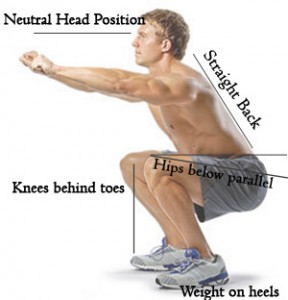From a young age I was taught that the barbell back squat is a staple for developing strength and power in the lower extremities. I have seen a number of ways to do them “correctly”, to minimize injury and maximize performance. Of course, these varying approaches could not all be right and so I started to ask myself, “what is the best way to do a basic barbell back squat?” Recently I did a review of the research and this is what I found.
Although it is not the only option, the deep back squat is a strong candidate for being the best option as it works the legs through a full range of motion and is safe if performed within basic parameters.
Feet:
To do them correctly we need to start from the bottom by talking about foot placement. A neutral position where the feet are shoulder width apart or slightly wider and the toes are neutral to 30 degrees pointing outward is recommended 1,2.
Knees:
Next we move up to the knees. Throughout the squatting movement the knees should move through a path roughly over the middle of the foot and should not project more than a few centimeters past the tip of the toes 1,2.
Depth:
Now that we have taken care of our feet and knees, we can talk about squat depth. Unless an individual has a pre-existing knee injury or is training for a sport specific posture, it is best to perform your squats to the point where your thighs are just past level with the ground at the very bottom of the movement. I find that my body naturally finds this position if I do the squats moving my feet and knees as described above, but it may take some cueing from a training partner for newer trainees to find this depth 3,4. In addition, a lordotic curve (shaped like a “C” opening away from the back) should be maintained in the lumbar spine throughout the entire movement. If the curve is lost it is likely that the trainee is squatting too low or is using too much weight.
Head:
Finally, the head should be kept upright so that the eyes are looking level throughout the lift 5. For a healthy person looking to increase their lower body strength, a squat performed within these parameters should be a safe option. For those who have knee pain or pathology some modifications may be necessary 1-7.
One modification might be to back your squats up by doing them at a shallower height for a time and then gradually working into lower depths as pain resolves. Alternatively, call a friend or a professional trainer to help you analyze your technique to see if it matches what is described above. And thirdly, your local physiotherapist will be able to clear more serious pathology and provide suggestions about other exercises you could do to help control your pain. Now, with this basic information in your possession, you can incorporate the barbell back squat into your exercise routine and expect an overall increase in your strength and overall sport performance.
Important Questions:
- Will deep squats performed past the point of a 90-degree bend in the knee cause knee injuries from greater pressure or shearing force in the joint? It is true that as the knee bends forces within it increase. However, two things come into play to help with this problem. First the wrapping effect of the patellar tendon on the knee and the effect of soft tissue approximation between the calf and the hamstrings come into effect at the lowest part of the movement to reduce pressures within the knee joint. Secondly, Performing the movement through a full range of motion lets you use less weight to get the same muscular gains, which means that in a roundabout way you are actually decreasing the pressures in your spine and the joints of your lower body as well 2,5,6,.
- What are some exercises that would be good for an elderly person to do to keep their legs strong? For this population a version of the squatting exercise called a sit-to-stand is an excellent choice and will help anyone in this situation to keep their legs stronger so that they can stay more active and involved in their lives. To perform this movement one would start with the same rules as I talked about above and lower themselves until they just touch the seat of a kitchen chair and rise back to the standing position. To start with one should use a chair with arms to help push up from the bottom of the movement.
- Should women do heavy squats if they do not want “big legs”? The research states that the activation of different muscles in the lower body changes when performing a squat to different depths and with different loads. Greater weights lead to a greater activation of the gluteal muscles that extend the hip and greater depths lead to greater activation of the quadriceps on the front of the leg that extend the knee. In general this means that instead of getting massive legs ladies will get more muscular bottoms when performing heavy squats.
Teagen Johnson MScPT Student
Resources
1. Suggs, T. (2012). Full squats or not – the original research revisited. Starting Strength. Retrieved from http://startingstrength.com/articles/squat_klein_suggs.pdf
2. Han, S., Ge, S., Liu, H., & Liu, R. (2013). Alterations in three-dimensional knee kinematics and kinetics during neutral, squeeze and outward squat. Journal of Kinematics (39). 59-66.
3. Beardsley, C. & Contreras, B. (2014). The increasing role of the hip extensor musculature with heavier compound lower-body movements and more explosive sport actions. Strength & Conditioning Journal, 36(2), 49-55.
4. Bryanton, A., Kennedy, D., Carey, P., & Chiu, F. (2012). Effect of squat depth and barbell load on relative muscular effort in squatting. Journal Of Strength & Conditioning Research, 26(10), 2820-2828.
5. Comfort, P., & Kasim, P. (2007). Optimizing squat technique. Strength & Conditioning Journal, 29(6), 10-13.
6. Hartmenn, H., Wirht, K., Klusemann, M. (2013). Analysis of the load on the knee joint and vertebral column with changes in squatting depth and weight load. Sports Medicine, 43, 993-1008.
7. Czaprowski, D., Biernat, R., & Kêdra, A. (2012). Squat – rules of performing and most common mistakes: squat – methodology of teaching. Polish Journal Of Sport & Tourism, 19(1), 3-12.



